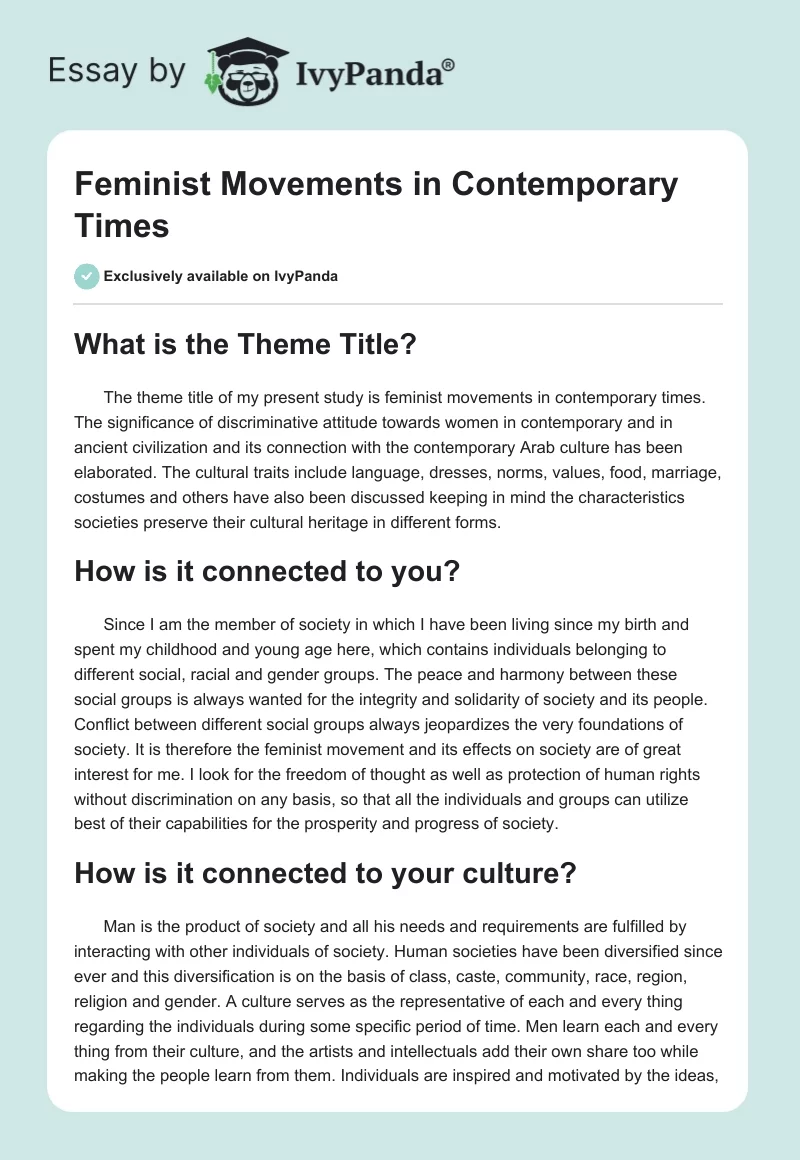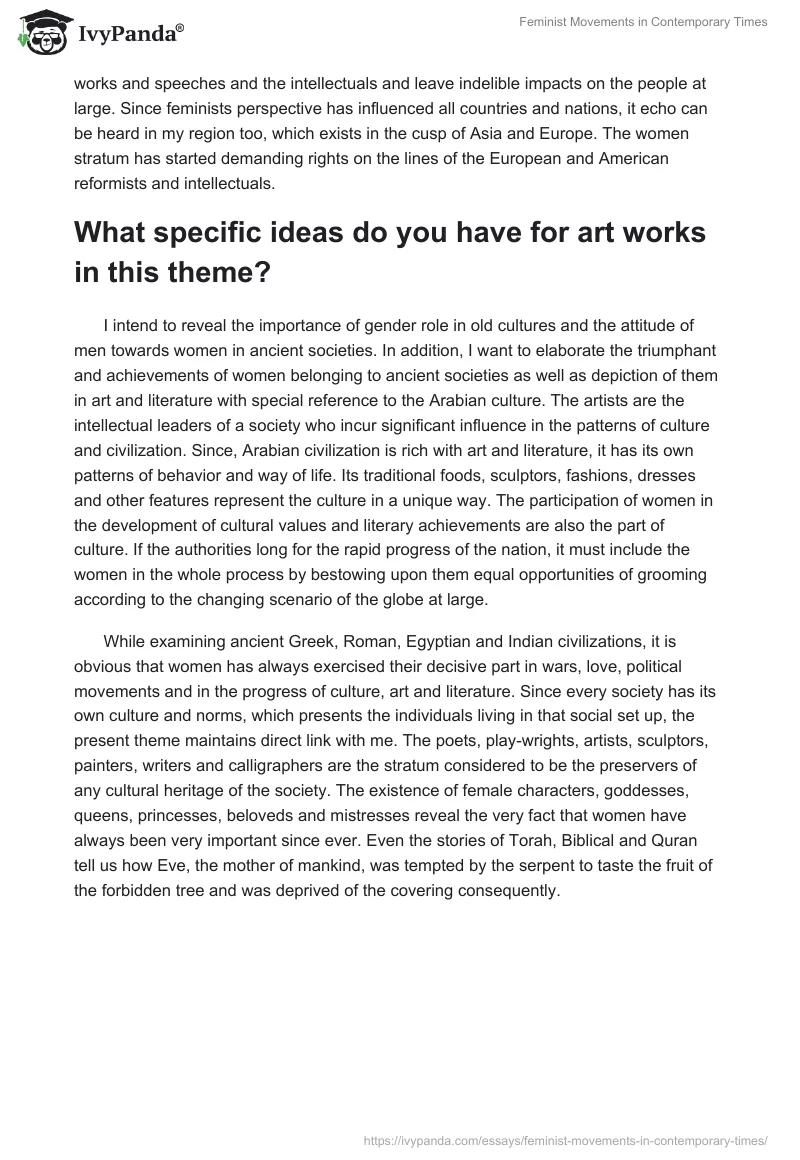What is the Theme Title?
The theme title of my present study is feminist movements in contemporary times. The significance of discriminative attitude towards women in contemporary and in ancient civilization and its connection with the contemporary Arab culture has been elaborated. The cultural traits include language, dresses, norms, values, food, marriage, costumes and others have also been discussed keeping in mind the characteristics societies preserve their cultural heritage in different forms.
How is it connected to you?
Since I am the member of society in which I have been living since my birth and spent my childhood and young age here, which contains individuals belonging to different social, racial and gender groups. The peace and harmony between these social groups is always wanted for the integrity and solidarity of society and its people. Conflict between different social groups always jeopardizes the very foundations of society. It is therefore the feminist movement and its effects on society are of great interest for me. I look for the freedom of thought as well as protection of human rights without discrimination on any basis, so that all the individuals and groups can utilize best of their capabilities for the prosperity and progress of society.
How is it connected to your culture?
Man is the product of society and all his needs and requirements are fulfilled by interacting with other individuals of society. Human societies have been diversified since ever and this diversification is on the basis of class, caste, community, race, region, religion and gender. A culture serves as the representative of each and every thing regarding the individuals during some specific period of time. Men learn each and every thing from their culture, and the artists and intellectuals add their own share too while making the people learn from them. Individuals are inspired and motivated by the ideas, works and speeches and the intellectuals and leave indelible impacts on the people at large. Since feminists perspective has influenced all countries and nations, it echo can be heard in my region too, which exists in the cusp of Asia and Europe. The women stratum has started demanding rights on the lines of the European and American reformists and intellectuals.
What specific ideas do you have for art works in this theme?
I intend to reveal the importance of gender role in old cultures and the attitude of men towards women in ancient societies. In addition, I want to elaborate the triumphant and achievements of women belonging to ancient societies as well as depiction of them in art and literature with special reference to the Arabian culture. The artists are the intellectual leaders of a society who incur significant influence in the patterns of culture and civilization. Since, Arabian civilization is rich with art and literature, it has its own patterns of behavior and way of life. Its traditional foods, sculptors, fashions, dresses and other features represent the culture in a unique way. The participation of women in the development of cultural values and literary achievements are also the part of culture. If the authorities long for the rapid progress of the nation, it must include the women in the whole process by bestowing upon them equal opportunities of grooming according to the changing scenario of the globe at large.
While examining ancient Greek, Roman, Egyptian and Indian civilizations, it is obvious that women has always exercised their decisive part in wars, love, political movements and in the progress of culture, art and literature. Since every society has its own culture and norms, which presents the individuals living in that social set up, the present theme maintains direct link with me. The poets, play-wrights, artists, sculptors, painters, writers and calligraphers are the stratum considered to be the preservers of any cultural heritage of the society. The existence of female characters, goddesses, queens, princesses, beloveds and mistresses reveal the very fact that women have always been very important since ever. Even the stories of Torah, Biblical and Quran tell us how Eve, the mother of mankind, was tempted by the serpent to taste the fruit of the forbidden tree and was deprived of the covering consequently.

Looking into the history of the world at large, it becomes evident that artists have not only worked hard to portray their civilization, but also have managed to conserve them. It is because of their works that the future generations assess how their society spent their life, what were their sources of income, which role their political system played for the benefit of the society and how they had developed their foreign relations with other states and countries. Aphrodite is considered as the goddess of love and beauty in Greek mythology, which is called as Venus in Roman mythology. Countless images, sculptors and paintings have been prepared by the artists to show the exemplary beauty she contained.



Since I am also a writer and poet, I take special interest in artistic work and themes. Being the student of literary criticism, I estimate the pieces of writing with critical angles and try to judge the meanings between the lines. I really look for the growth of art and demand for taking more and more steps from the government for the appropriate admiration and encouragement of all forms of art and literature. The supporters of literature are the benefactors of society who think and love to perform for the uplift of their society by welcoming intellectuals, philosophers, writers and artists. The artists not only determine the path of the individuals towards success and glory, but also indicate the flaws and weaknesses of the social set up in which they are living and leading their life. I also take closely how Egyptian Queen Cleopatra displayed her velour while leading her forces against Julius Caesar.
While looking at my own Arabian culture, it is obvious that women are unable to take part in all activities of life from social to political and from financial to medical department. But they are respected in the society. The respect of women was not the case before the advent of Islam, when they were looked down upon. The idols of goddesses had been located in different places of worship, which can be seen in the museums as cultural heritage. Moreover, poetry was also produced by women those days as it has been being produced today. European literature also mentions great names of women in the world of art. I long for a comfortable and pleasant atmosphere for women folk so that they can exercise their abilities in a better atmosphere. It will surely add to the developments of literary genres on the one hand and will diminish the fear of conflict between the genders.
Feminist movements may create an uneven social and political atmosphere, where everyone will be in a warring position with the other. Political movements in the name of gender, class, race and community destroy the nations. It is therefore, there is no barricade of giving vent to one’s ideas and notions at any platform in my culture. Strict policies regarding observing the veil and discouraging attitude of males regarding women’s participation in jobs and political activities are creating a fuss among woman folk and rift of differences between the two genders is going to be widened continuously. The banishment of woman’s movement and strict checks on their activities has kept the Arab world far from the advanced countries. Hence, if women are supported to add their share in nation building programs, our culture will not only be more prosperous one, but also it will make significant progresses by leaps and bounds.

How many aspects (or sub-themes) are related to this theme?
There are many aspects related to one single idea and theme. These include exploitation, gender discrimination, social conflict and uncertainty. The absence of women in marches against war in Iraq and Afghanistan has presented these countries as isolated and backward ones, and it had become easier for the USA to overcome their resources, territories and people.
Which media (i.e. More than one) do you want to work with?
Since I am a poet myself, I would like to write poems and array them in such a way that they become the voice of the people at large. It is therefore, John Milton, Jane Austen, Emily Bronte and Virginia Woolf especially appeal my thoughtfulness. All these poets and writers beautifully portrayed their ideas and infused new ideas in people and readers. Moreover, I would like to apply paintings and sculptors for the uplift of art created by women and try to paint the pictures describing equality and freedom of thought and action. I am optimistic that all such works and efforts will mean a lot to the cause of social justice and equality.



